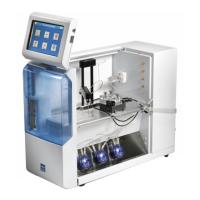151
Baseline Stability 12.4
The 2900 Series monitors the probe baseline activity and stability. If an unstable baseline is detected, the instrument will
continue to flush the sample module with buffer. When a stable baseline is established, an automatic calibration is
initiated.
After every calibration and sample, the final baseline value (i
fb
) is compared to the initial baseline value (i
ib
) during the
flush cycle. If a significant shift is detected, the sample module continues to be flushed with buffer. As soon as the
baseline recovers, buffer flushing ceases and the instrument performs its next command. There is a limit of about 3
minutes, at which time the instrument displays a baseline error message.
Calibration 12.5
To maintain a sample ready status, the 2900 Series self-calibrates. Calibrating establishes the sensors’ response to a
known concentration of substrate.
The enzyme sensors calibration response must be above 5 nA. A response below this value will result in an error (low PL
current).
The 2900 Series self-calibrates enzyme sensors every 5 samples or 30 minutes. However, default calibration parameters
can be altered to tighten or loosen calibration specifications. A manual calibration can be initiated from the [Run],
[Calibrate] tab.
A STABLE CALIBRATION IS IMPORTANT. The instrument re-establishes a calibration reference point after every
calibration. If a difference of more than 2% between the present and previous net calibration values occurs, the instrument
repeats calibration. The sensors’ net value for a calibration (PL) is displayed and printed. An unstable calibration is
displayed and printed as a "PL shift". While establishing a stable calibration, the 2900 Series will run 5 calibrations before
aborting calibration for a sensor. The flexible parameter selection allows the user to disable this error mode.
In summary, by the default enzyme sensor calibration settings, recalibration will occur after every 5 samples or 30
minutes, after a calibration shift of 2% or greater, or after a sample module temperature drift of more than 1°C. After 5
attempts without successfully calibrating, the instrument aborts calibration for that sensor.
Linearity 12.6
As discussed earlier, an enzyme sensor consists of an electrode and an enzyme membrane. As a membrane ages, its
response becomes non-linear (shown in Error! Reference source not found.).
Aging Enzyme Membrane Response
Figure 12.3

